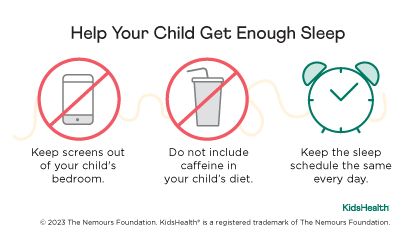A child having a night terror (also called a sleep terror) wakes up screaming and thrashing and is impossible to comfort. Eventually they go back to sleep and usually won't remember the night terror when they wake. Night terrors can be scary for parents to see but are not harmful to children. Most kids outgrow them before the teen years. Here are some ways to help prevent night terrors and to comfort your child if they happen.



The night terrors:
Also talk to your health care provider if your child:

What happens in night terrors? Night terrors happen when a child partially awakens and the part of the brain that controls "fight-or-flight" responses becomes overexcited. This makes the child feel panicked and terrified. They will act very upset and may scream, thrash around, or get out of bed. This usually happens about 2–3 hours after a child falls asleep when the brain is in the non-REM (non-rapid eye movement) stage of sleep.
What causes night terrors? The exact cause of night terrors is not known. They tend to run in families so there's probably a genetic link. Some things can trigger night terrors, such as:
What's the difference between a night terror and a nightmare? Night terrors and nightmares happen during different sleep stages. Night terrors usually happen in the first few hours after a child falls asleep, while nightmares tend to happen later. A nightmare often will wake a child, but kids usually don't fully wake during night terrors. Children rarely remember anything about a night terror the next day but usually can remember parts of a nightmare. Night terrors are very rare in adults, but people of any age can have nightmares.